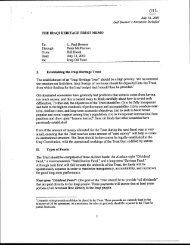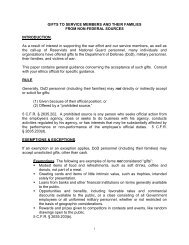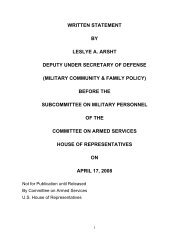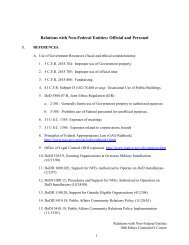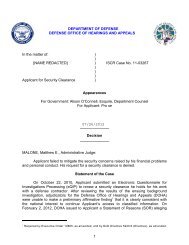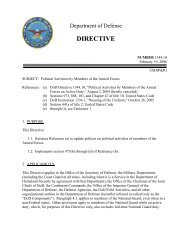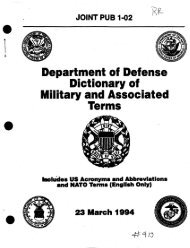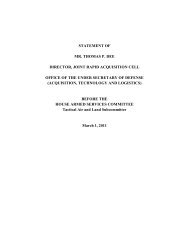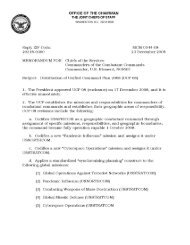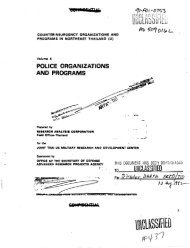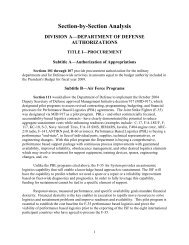dod tactical herbicide sites - United States Department of Defense
dod tactical herbicide sites - United States Department of Defense
dod tactical herbicide sites - United States Department of Defense
Create successful ePaper yourself
Turn your PDF publications into a flip-book with our unique Google optimized e-Paper software.
(a Chemical Corps Officer assigned to this subordinate element <strong>of</strong> the Eighth US Army)would be physically present whenever defoliants were deployed. By 20 March 1968, thefirst <strong>herbicide</strong> (Monuron) and equipment arrived in country. On 31 March,implementation <strong>of</strong> the Vegetation Control Program CY 68 (for Calendar Year 1968) wasordered to begin on or about 15 April 1968. On 10 April 1968 supplies <strong>of</strong> HerbicidesOrange and Blue were on-hand in forward locations near the DMZ.Assessment: Soldiers from the First Republic <strong>of</strong> Korea Army (FROKA) wereassigned the task <strong>of</strong> applying the <strong>herbicide</strong>s. Monuron UROX 22 was spread by hand ormechanical broadcast beginning on 15 April 1968 and through 28 April 1968. The usualtechnique involved dividing a selected area into several lanes and each soldier walkedalong his assigned lane spreading the Monuron pellets along an area <strong>of</strong> 5 meters on eachside <strong>of</strong> his marked lane. Supplies <strong>of</strong> Monuron were spotted throughout the area t<strong>of</strong>acilitate individual re-supply along assigned lanes. In this manner, approximately 7,800drums (397,800 pounds) <strong>of</strong> palletized <strong>herbicide</strong> were applied on 1,560 acres or at a rate<strong>of</strong> 255 lbs/A.Applications <strong>of</strong> the <strong>tactical</strong> <strong>herbicide</strong>s Orange and Blue began on 15 May 1968 upon theemergence <strong>of</strong> foliage, and terminated on 15 July 1968, The Orange <strong>herbicide</strong> was mixedwith diesel oil at a ratio <strong>of</strong> 3 gallons <strong>of</strong> Orange to 50 gallons <strong>of</strong> diesel. Since manyapplication areas selected for spraying with Orange were relatively inaccessible for use <strong>of</strong>the modified M8A2 Decontamination Trailer, 22 liquid defoliant spray sets wereemployed. These units were insecticide sprayers commonly used in EngineerEntomological Services and consisted <strong>of</strong> a portable lightweight hypro-type pump with astandard gasoline engine. The Republic <strong>of</strong> Korea Army (ROKA) also had available tenM106 “Mitey Mite” dispensers that were used to supplement liquid spray capabilities.The M106 was a commercial, backpack sprayer that consisted <strong>of</strong> a compact two-cyclegasoline engine that dispersed the <strong>herbicide</strong> through a 6-foot hose. The tank contained 3gallons <strong>of</strong> liquid. The modified M8A2 Decontamination Trailers were used for sprayingboth Orange and Blue. The unit consisted <strong>of</strong> a 200 gallon capacity tank and a 25 HP GEDpump mounted on a 1 ½ ton trailer. A single hose reel allowed the operator to moveapproximately 50 feet from the trailer and direct a liquid spray through the adjustableBeam type spray gun at a rate <strong>of</strong> 20 gallons per minute.Approximately 380 drums <strong>of</strong> Orange (20,900 gallons) were applied on 6,966 acres (3gallons/acre). Herbicide Blue was applied as a liquid spray mixed with water at a ratio <strong>of</strong>3 gallons <strong>of</strong> Blue to 50 gallons <strong>of</strong> water for application on one acre. Approximately 625drums <strong>of</strong> Blue (34,375 gallons) were applied on 11,458 acres (3 gallons/acre). As noted,all applications were done by ground-based spray systems. The use <strong>of</strong> masks andhandling precautions were mandatory. The report noted that 3,345 FROKA soldiers wereinvolved in the actual spray operations. No US military personnel were used to spray the<strong>tactical</strong> <strong>herbicide</strong>s, or were involved in any <strong>of</strong> the spray operations, e.g., mixing <strong>of</strong> the<strong>herbicide</strong>s and diluents. US military personnel (Chemical Corps Officers) were used tomonitor and report on the activities <strong>of</strong> the ROKA Forces.52



